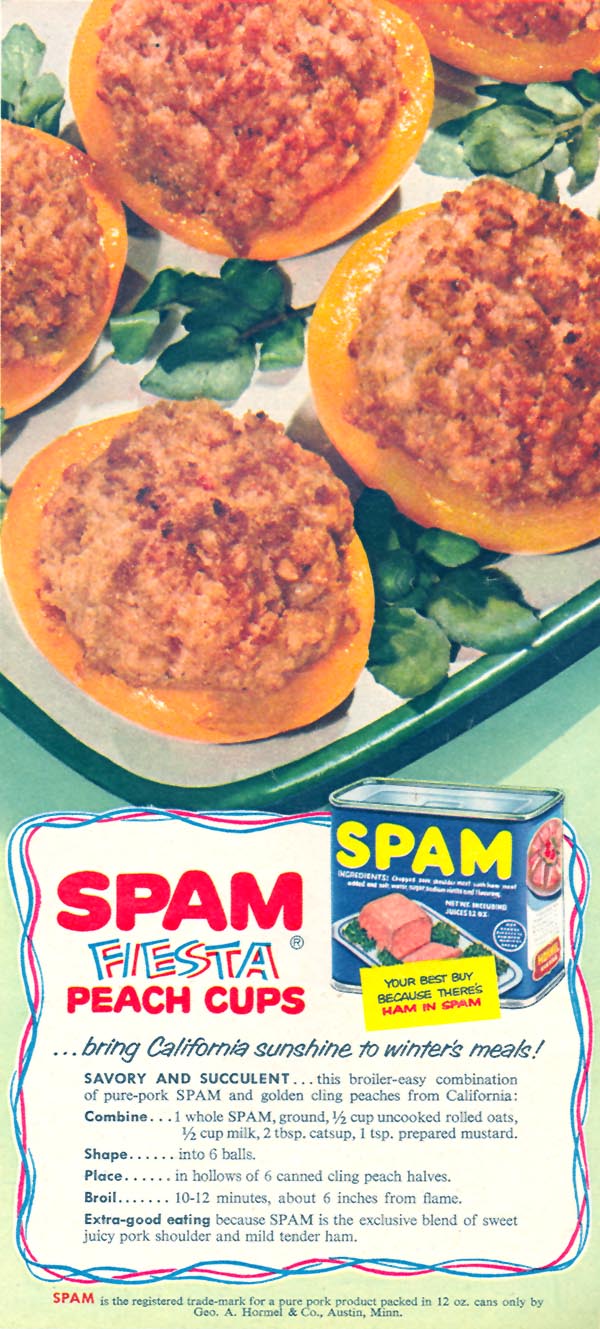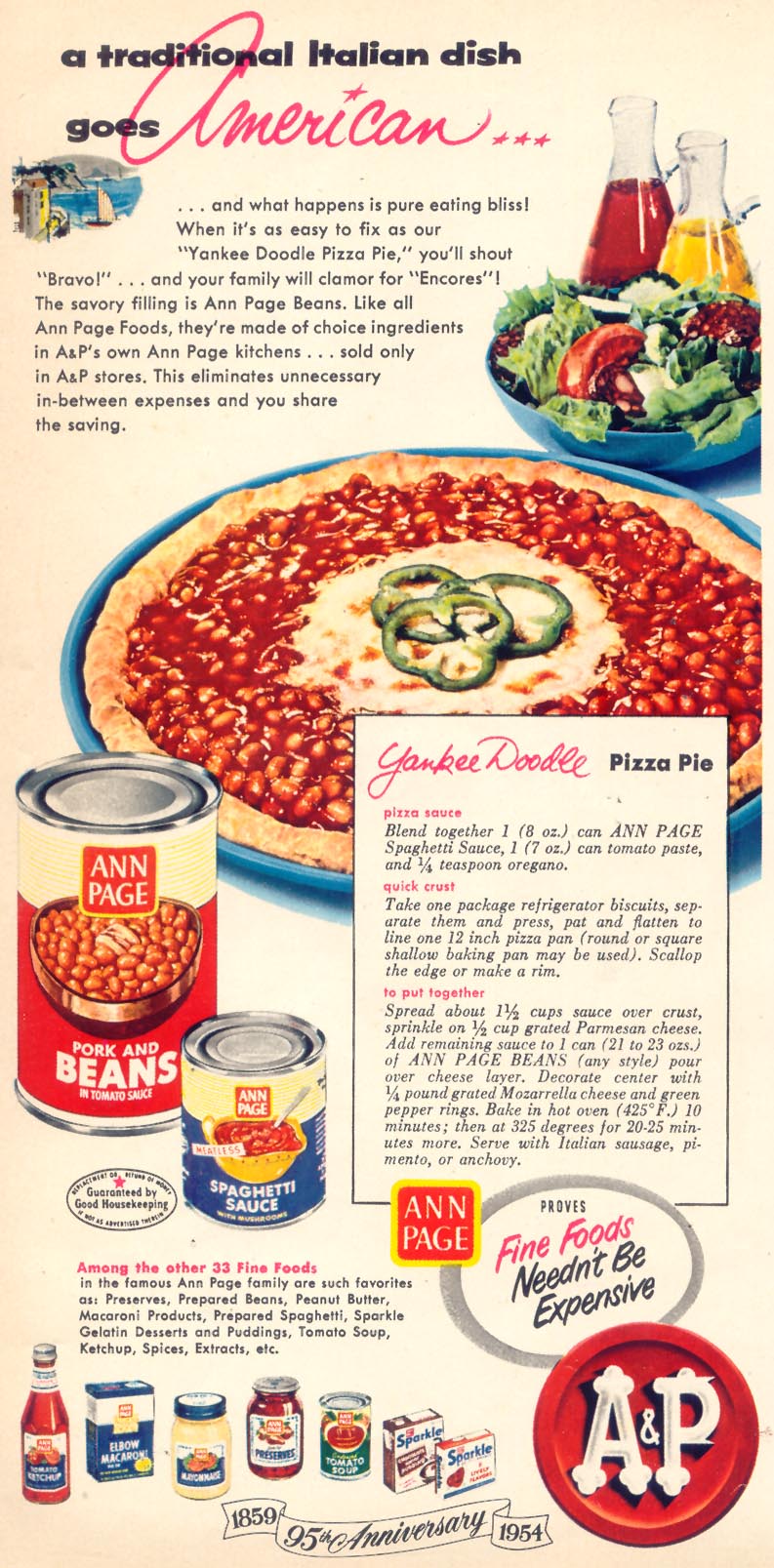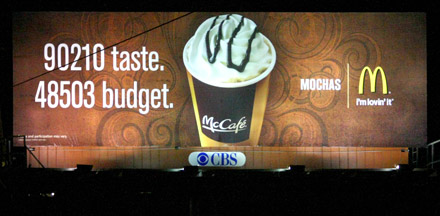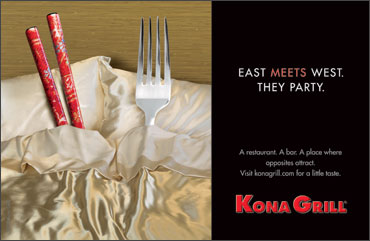Select text: “These well-stacked Sno-Balls have more than sex appeal… they have sales appeal!”
The 1960s via Found in Mom’s Basement.
More sexualization of food here, here, here, here, here, here, and especially here.

I can safely say that most readers of this blog probably think that broiled Spam + canned peaches looks and sounds unappetizing. But this is only one of many creative food combinations that appeared in advertisers’ recipes and cookbooks during the 1950s and 1960s. Here’s another:

Why, yes, those are baked beans on pizza.
While there are plenty of interesting angles on these old recipes, from their use of color to their emphasis on saving money, I’d like to bring up the way that modern writers treat recipes from this period. James Lileks, for example, has an entire site, The Gallery of Regrettable Foods, which eventually spawned a book covering much of the same material.
As the index page to The Gallery of Regrettable Foods says,
What were they thinking? How did they eat this bilge? Good questions, but you won’t find them answered here. This is a simple introduction to poorly photographed foodstuffs and horrid recipes. It’s a wonder anyone in the 40s, 50s and 60s gained any weight; it’s a miracle that people didn’t put down their issue of Life magazine with a slight queasy list to their gut, and decide to sup on a nice bowl of shredded wheat and nothing else.
This [admittedly funny] type of snarky commentary has inspired other Web sites, such as Wendy McClure’s mockery of 1970s Weight Watchers recipe cards. The vintage_recipes community on LiveJournal frequently contains less formal versions of the snark.
Such modern commentary erases much of the historical significance and interest of these recipes. The radio program Engines of Our Ingenuity recently commented on the cookbook in episode 2403, with a special focus on recipes such as those shown above. As the transcript of episode 2403 suggests, many of these recipes relied on canned, gelled or prepared foods, highlighting both the Atomic Age’s fascination with technologically advanced cookery. But the mockery is way more popular these days.
These images could be used in a discussion about how “retro” images are regularly reappropriated as “cool” with little regard for their historical context.
Chelsea C. brought our attention to this billboard for McDonald’s coffee or McCafe:

90210 is the zip code for Beverly Hills, a notoriously rich neighborhood in California. And, Chelsea explains, 48503 is a zip code in Flint, Michigan.
The ad is interesting to me because of the double meaning of taste (hello Bourdieu!). Taste refers to how things taste on your tongue (literally the taste of the coffee), but it also refers to who has good versus bad taste (people with good taste are “high class” and they like things like classical music and caviar). The idea that this ad is capitalizing (pun intended!) on both meanings of the word taste is supported by the use of the term “cafe” in “McCafe” and the portrayal of a fancy coffee drink (“Mochas”).
So the ad is saying that, even if you live in Flint and don’t have the economic resources of someone who lives in Beverly Hills, you can have the taste of expensive coffee because, of course, expensive coffee is to your taste.
There is something interesting here that ties into our consumer culture and wide range of advertising, television programming, and Paris Hilton-watching that encourages us to aspire to be just like the rich. This means buying expensive things that you can’t really afford and/or valuing things that mark you as a high class person with good taste (such as Mochas from McCafe, if that’s the best you can do). There is no questioning as to whether it’s a good idea for everyone to aspire to such heights, whether there is something problematic in the disparity between 90210 and 48503, or even whether it’s true that the rich have better “taste.” So, ultimately, the hierarchy goes unchallenged while we all just jocky for position.
This reminds me of the moment in the Sex and the City movie when Carrie realizes that her assistant, Louise, rents super-expensive purses even though she is too poor to buy them. Carrie is impressed by Louise’s “taste” and her dedication to having “the best” things even if they are completely inessential and renting them only exacerbates the fact that she doesn’t have oodles of cash.
So, yeah, I think this billboard plays into that.

MissCegenation (see her take over at Reciprocal Crap Exchange), Miguel E. (of El Forastero), Breck C. (also of Reciprocal Crap Exchange), Rachel N., Laura M.D., and Z. (of It’s the Thought that Counts) all sent in links to Burger King’s “Whopper Virgins” viral video campaign (we’ve never had so many people send in the same thing; clearly it touched a nerve):
There are several interesting things going on here. One is the exoticization of the “whopper virgins.” The taste tests were conducted in Thailand, Romania, and Greenland. We’re clearly supposed to find it charmingly cute that they’re unfamiliar with hamburgers. They don’t even know how to eat them! We get to see people taking their “first bite of a hamburger,” and wonder at their unfamiliarity with how to pick one up and eat it. This short video about the Thailand taste tests illustrates this with the dramatic voiceover about people who have “never even seen a burger. Who don’t even have a word for burger.”
There’s also a certain level of ethnocentrism here; note the comment that these are people who “really live outside of things.” That all depends on what you mean by “things,” which here seems to be defined by exposure to TV and hamburgers. The implicit understanding, of course, is that these are people who live in a backward, “traditional” culture, which is fascinating to outsiders but, ultimately, very bizarre. However, I am sure that if asked these people would feel they live “inside of” many things, just not the things considered important to this marketing team.
You might also use this to talk about the pervasiveness of advertising. As the video makes clear, they went to Thailand, Romania, and Greenland in hopes of finding people who hadn’t been exposed to Burger King or McDonald’s advertising, since it would be “impossible” to find such people in the U.S.
I also think the documentary element to the video is fascinating. I’m assuming the teams did travel to these areas, and the video claims they are all “real people,” not actors (who are, apparently, imaginary). But I have a suspicion that some elements were staged. Of course the taste-tests were staged, but I notice that almost everyone in the videos is wearing “traditional” clothing. I might be wrong, but it doesn’t strike me as the type of clothing people would wear every day–they seem like pretty fancy clothes that you’d wear for special occasions, but maybe I’m wrong. If anybody knows more about how people in these areas usually dress, let me know. Of course, it’s entirely possible that people dressed up in their fancier clothes entirely on their own because they wanted to look nice when being filmed. But I wonder if they were encouraged to dress in clothing that would make them seem more exotic, rather than showing up in a t-shirt (which is, by now, fairly universal, though I’m certain there are still groups who have not adopted t-shirts).
The second half of the video, where the Burger Team goes to villages in each country and makes them Whoppers, is also interesting in the way it portrays the team as philanthropists giving these communities a unique cultural experience. I mean, I guess they are, and I don’t want to fall into the trap of romanticizing “traditional” groups and implying that they should be shielded from “modern” innovations because it would ruin their culture. And it doesn’t seem like the marketing team is really trying to build brand loyalty, since it’s unlikely they’re going to be opening stores in any of these areas (although they do make sure to wrap the burgers in Burger King wrappers). It does, on the other hand, make the video seem more like a documentary and less obviously like a commercial, which adds to its effectiveness as a viral ad. I dunno. Maybe this is just an example of a corporation doing something nice, and I can’t get over my general distrust of marketers.
Another interesting angle you might bring up in discussion is the spread of fast-food culture and standardized, relatively cheap production processes in general, often referred to as “McDonaldization.” There’s also an entire book on the subject of McDonald’s in Asia, called Golden Arches East: McDonald’s in East Asia (edited by James L. Watson). I sometimes assign the chapter “McDonald’s in Hong Kong: Consumerism, Dietary Change, and the Rise of a Children’s Culture” in my intro classes to talk about cultural change; it’s fascinating how McDonald’s is to some degree undermining parental authority by appealing directly to children and empowering them to demand their favorite meals.
Laura sent us a link to a story about criticism of the campaign, found here.
And just an aside here: What’s the difference between a “village” and a “small town”? The word village seems to bring up certain assumptions about both quaintness and backwardness (and cultural isolation). I grew up in a town of slightly less than 300 people. Nobody ever called it a village. Is it a village if you don’t have paved roads, and a small town if you do? I’m just askin’.
Thanks to everybody who sent the video in!
Welcome to Christmas 2008!
Rose McM. sent us this great example of rigidly gender-coded toys from the Sears Wish Catalog (click to enlarge):
NEW! (Jan. ’10): Sarah O. snapped this photo of toys that teach girls they should cook and care for babies, while boys can build things and be doctors:

See also these posts on the Rose Petal Cottage and Tonka Trucks (“built for boyhood!”).
Lisa Wade, PhD is an Associate Professor at Tulane University. She is the author of American Hookup, a book about college sexual culture; a textbook about gender; and a forthcoming introductory text: Terrible Magnificent Sociology. You can follow her on Twitter and Instagram.
From 1987 (found here):
No date (found here):
Also in “Oriental” stereotypes: a new restaurant in Rhode Island and Oriental Pearl Cream.
Kona Grill specializes in “imaginative meals.” In their ad campaign (discovered here), they sexualize their mixing of usually segregated culinary traditions (“East meets West”). Here they put a fork and chopsticks in bed together:

Their food, apparently, is like interracial sex. This is interesting in itself, but the copy goes further. It reads:
A restuarant. A bar. A place where opposites attract. Visit konagrill.com for a little taste.
So not only are East and West (or Asians and Americans) different, they’re “opposites.” Such advertising not only fetishizes interracial relationships, but it reinforces the idea that race and culture are such powerful and defining characteristics that people from the East and the West could not possibly have anything in common (except sex, of course).
Even in an era when children’s obesity is a significant problem (though a commenter points out that this is contested), the ever-upping of serving sizes at McDonald’s doesn’t appear to be skipping kids. Stephen W. took this picture at a McDonald’s in Pennsylvania this week.
Now McDonald’s doesn’t just offer Happy Meals, but Mighty Meals. Mighty Meals include a double cheeseburger instead of a hamburger or cheeseburger or a 6-piece McNugget instead of a 4-piece.
By the way, a Mighty Meal with a double cheeseburger has 780 calories.
And, really, what kid doesn’t want to be mighty? McDonald’s will sink pretty low for a few extra pennies.
Thanks for the tip and the picture, Stephen!